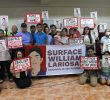DAVAO CITY – Lumads trooped to the National Commission on Indigenous Peoples (NCIP) XI to protest the occupation of the 66th Infantry Battalion in their community in Compostela Valley.
The NCIP denied there were reports of militarization in the communities.
Last December 1, some 133 Lumads from Sitio Side 4, Barangay Mangayon, Compostela arrived here after they were “displaced” by the Army.
Cristina Lantao, a Matigsalug woman and secretary general of the Sabokahan Lumad Women organization, said the Army stayed in the school which was located at the center of their community.
Lantao cited the military’s occupation came months after the same soldiers “indiscriminately fired” at the house of their community leader which almost killed a child.
Lantao said the Army attack came after they put up a barricade in opposition to the entry of the Agusan Petroleum Minerals Corporation (AgPet) in their community.
Read related story: Farmers put-up camp to halt mining exploration in Compostela Valley
“Maayo gani ang bata kay luhagan, wala naigo, nakalikay. So gikuha sa iyahang lola didto padulong sa ubos, didto sa yuta nagdapa, naghinay-hinay padaplin palayo sa ilahang balay nga gi rakrakan og maayo sa 66th IB (Good thing the child was energetic as he was able to avoid getting shot. His grandma snatched him just in time after the soldiers riddled the house with bullets),” said Lantao.
NCIP XI Regional Director, Atty. Geroncio Aguio in an interview Monday said they did not receive any report on militarization from their provincial office in Compostela.
Aguio claimed the government projects are beneficial to the lives of the Lumads.
“Okay man sila (Lumads), wala man silay mga problema. Okay man ilahang (pagdawat) sa mga programa (They are okay, they don’t have problems. They received the government programs well),” said Aguio, citing the recent gathering of indigenous peoples who are holders of the Certificate of Ancestral Domain Titles last month in Tagum City.
Lantao slammed the NCIP for backing the military. She linked the militarization to their continued opposition to Agpet’s mining exploration in their 12-hectare domain.
To this, Aguio claimed: “Ilaha tong istorya kay ang process sa NCIP, dili man ing-ana, sila man nag-allow, ang community man nag allow. Igo rami nag-document” (It is just their story because that is not how it works in NCIP, their community allowed, we were just tasked to document it).”
“Dili kay giingon sa isa o tulo, mao na nay issue (Not because one or three said so, then that’s the issue),” he said.
“The future of thousands of Lumads rests in nine to 10 domains in Compostela Valley, and this cannot be changed by 150 people,” said Aguio.
In a data presented by NCIP XI, as of June this year, there are 14 ethnic indigenous people that comprise Region XI where, 14,076 Lumads come from Compostela Valley.
“Ang 14,000 ka population, dili pwede usbon ang collective decision sa 150 ka tao (150 people cannot change the collective decision of 14,000 people),” said Aguio.
Aguio encouraged the Lumads to settle the problem in their community with the presence of their recognized community leader.
Lantao said they have inherited the lands from their ancestors and they will never allow the entry of big mining companies.
She said they are opposed to mining because their lands which serve as their “pharmacy, market and hardware” will be destroyed.
“Dinha gud mi ga kuha og herbal, kung mapaakan og bitin, wala man na sa botika, kanang ihaplas ba, wala na sa botika, pero sa amoang lasang makuha na namo (We get the herbs there as cure-all like for snakebites. There’s no oil for the snake bite in the pharmacy but it is found in our forest),” she added.
“What will happen to our children if our forest is lost?” she said. (davaotoday.com)










